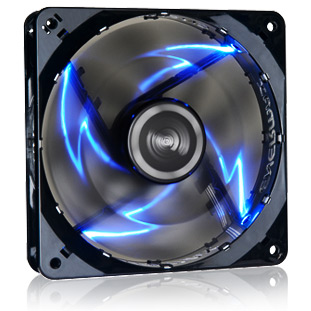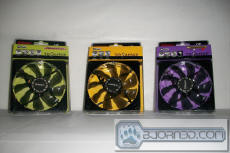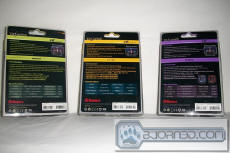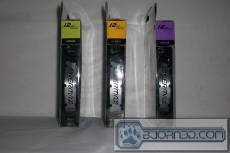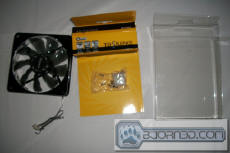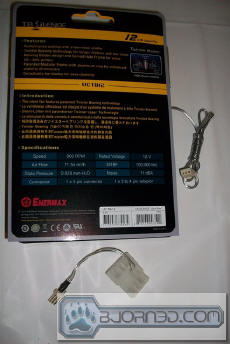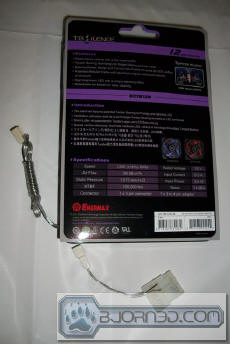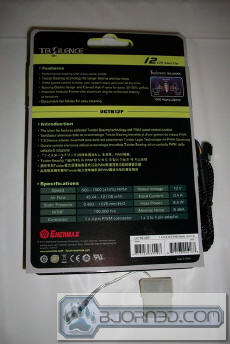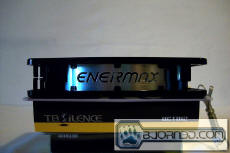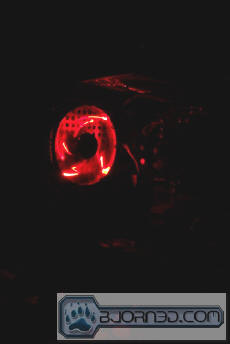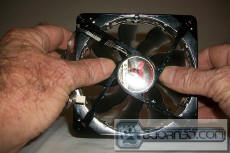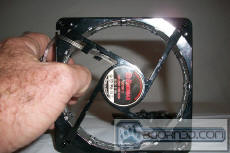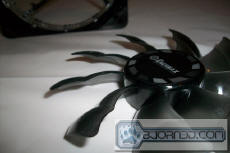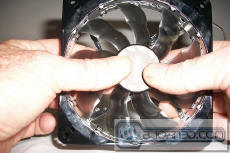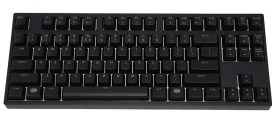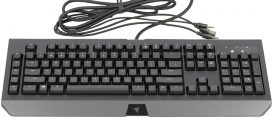Enermax’s new 120mm fans are colorful, and look nice, but how do they hold up in our torture testing? Keep reading to find out!
Introduction
When talking about computer systems, one topic sure to come up is heat and air flow. To remove the heat from within a computer case, we use fans. But which fans? Fast, noisy ones? Quiet ones that only move tiny amounts of air? Luckily. consumers currently have more choices than that.
In this review, we are going to consider some choices from Enermax. Understanding that enthusiasts want to be able to move air through their cases quietly, Enermax has created the TBSilence fans. They price from $5 to around $13-$14 depending on the size and type. Ranging in size from 80mm to 140mm, these fans come in four different configurations: a PWM controlled fan, a fixed RPM model, a lightning LED fan, and a manual speed control model.
Today we will be specifically looking at the 120mm PWM controlled, fixed RPM, and lightning LED (in red) models.
features
- Performance cooling with a low-noise profile
- Twister Bearing technology for longer lifetime and low noise
- Batwing Blades design and Carved Halo Frame for extra 20~30% airflow
- Patented Modular Frame with aluminum ring for enhanced stability of structure
- Detachable fan blades for easy cleaning
- High brightness LED with a unique lightning effect (Lightning LED model only)
- PWM speed control to keep your system silent and cool all the time (PWM Speed Control model only)
|
Twister Bearing technology |
||||||
 |
1. Nano magnetic design – Self-lubricating – Minimal friction – Long lifetime – Low noise |
|||||
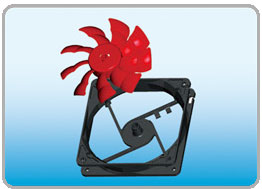 |
||||||
| 2. Detachable blades design -Easy popping out – Easy cleaning |
||||||
| TBSILENCE Series (12CM) Fan Specifications | |||
| Specification | TBSILENCE fixed rpm UTCB9 |
TBSILENCE Lightning LED UCTB12N-R (the blue ends in BL) |
TBSILENCE PWM Speed Control UCTB12P |
| Dimension (mm) | 120 x 120 x 25 | ||
| Bearing Type | Twister Bearing | ||
| Frame | Carved Halo Frame | ||
| Blades | Batwing Blades | ||
| Blades Number | 9 | ||
| LED Color | N/A | Red (as tested, blue available) | N/A |
| LED Number | N/A | 4 | N/A |
| Speed (RPM) | 900(±10%) | 1200 (±10%) | 500-1500 (±10%) |
| Air Flow (CFM) | 42.11 | 53.02 | 26.51 – 71.25 |
| Air Flow (m3/h) | 71.54 | 90.08 | 45.04 – 121.05 |
| Static Pressure (mm-H2O) | 0.828 | 1.073 | 0.483 – 1.676 |
| Noise (dBA) | 11 | 14 | (Minimal) 8 |
| MTBF (hour) | 100,000 | ||
| Rated Voltage (V) | 12 | ||
| Input Power (W) | 1.8 | 3.6 | 4.8 |
| Input Current (A) | 0.15 | 0.3 | 0.4 |
| Accessory | — 4 x screw & 1 x 3 to 4 pin adaptor — | ||
| Safety & EMC | TUV, UL, CE, ROHS, WEEE | ||
A closer look
The packaging is fairly straightforward, using eye-catching colors rather than flashy pictures, or logos. The rectangular boxes hide the wires, adaptor, and four screws
The reverse side lists the features, and specifications, and contains one line which reads “The silent fan features patented Twister bearing technology” and is repeated in seven other languages. The PWM and LED packages add those functions to the text. All other text on the package is in English only.
The sides are by necessity plain listing only the size and model number, while allowing consumers to view the “Halo” ring.
As the contents of each package were virtually identical this is what we see once the package is opened.
Here’s a look at the rear panels with out the plastic.
Looking closely we can see how the composite frame is constructed. The brushed aluminum adds both good looks and strength to the assembly. along with another view of the frame in more “natural” lighting. We can see here that the frame locks together at the corners while keeping the ring from moving.
We couldn’t get our camera to capture the lightning effect like the picture from the Enermax site (first page) but We can confirm that everyone who was asked “What do you see?” replied “A lightning bolt”. The second picture is from a slightly different angle. Readers should take note that if they are looking for a fan that will light up the inside of their cases, this is not it. This fan give a lightning effect more so than actual lighting. It is, however, a very cool effect in our opinion. As can be seen in the third picture, the effect shows up even in bright lighting conditions. It should be noted the fan was mounted into this case for the sole purpose of taking these pictures.
Removing the fan blades is a simple procedure. We just firmly grip the frame with our fingers, place our thumbs as close to the center of the fan as possible and apply even pressure. We recommend keeping the fan over a desk or table to avoid having to pick the blades up from the floor.
The halo frame and blade disassembled
This is the PWM fan. Notice that it has a 4 wire connector and a sleeved cable. It is the only one of the 3 fans with these features. As we can see here, the blade design does bear a remarkable resemblance to a bat wing. Replacing the blades is as simple as putting them back on the shaft, gripping the frame tightly, and pressing until they pop back into place.
Testing & Results
When testing any equipment it is important to remember what the true purpose of that equipment is. For the fan it is to move air for the purpose of exchanging heat with cool. With that in mind, we chose to test these fans in a system running an overclocked AMD Phenom 9500 using StressCPU2 (a win32 executable) to run floating point calculations for 30mins per fan. As a secondary test we ran Prime95 (x64 executable) for 45 minutes per fan. For Prime95 we ran a Torture Test, In place large FFT’s (maximum heat, power consumption, some RAM tested). Both applications run a 100% load.
| Test System | |
| Case | Thermaltake Tsunami Dream (circa 2004) {modified} |
|
Processor |
AMD Phenom X4 9500 (Agena) 2.2GHz (O/C @ 2.54GHz)
|
|
Motherboard |
ASUS M3N-HT Deluxe |
|
Memory |
4 GB Patriot 8500EL series PC2-6400 (2x2GB) |
|
Drive(s) |
Maxtor 7H500F0, WDC WD 1600BEVT |
|
Graphics (Driver) |
Card 1: XFX 9800GX2
Card 2: EVGA GTX260
Card 3: Gigabyte GTX560 OC
|
| Power Supply 1 | Antec True Power Trio 550watt PSU |
|
Power Supply 2 |
XFX 750W POWER SUPPLY BLACK EDITION |
| Operating System | Windows XP x64 SP2 |
| Fan controller | NZXT Sentry2 (not used for testing) |
| Case fans | N/A (off during tests) |
This case has been Modified by adding a second PSU to the top of the case in it’s own housing, drawing airflow through the top of the case via a 120mm hole dead center of the top.
Testing consisted of using each fan in turn on a copper heat-pipe cooler attached to the CPU, measuring idle and full load temps, with the case open. The tests were performed in descending order based on the rated maximum RPMs of each fan.
The system was allowed to run for 20 mins at IDLE before reading temps. Ambient temperature = 20.5°C (69°F)
The PWM Fan test
The PWM Fan is rated at 26.51 – 71.25 CFM with a minimum noise level of 8 dB(A) (claimed). There is no data concerning the maximum level.
TBSilence PWM |
min temp | avg temp | max temp | RPM range |
| Idle | 30°C (86°F) | 31°C (88°F) | 32°C (90°F) | 1159-1227 |
| StressCPU2 at load 30 mins | —– | 39°C (102°F) | 41°C (106°F) | 1352-1418 |
| Prime95 at load 45 mins | —— | 40°C (104°F) | 41°C (106°F) | 1380-1451 |
| Avg temps based on value observed most often while running tests. Data obtained from CPUID Hardware Monitor vers. 1.17.0 |
||||
The PWM fan took less than one minute to return the CPU to idle temps.
The Lightning LED fan test.
The LED Fan is rated at 53.02 CFM with a noise level of 14 dB(A) (claimed). It produces a nice glow in the center of the case when strapped to the cooler, though due to its orientation facing down, the lightning effect cannot be observed.
TBSilence LED |
min temp | avg temp | max temp | RPM range |
| Idle | 30°C (86°F) | 31°C (88°F) | 32°C (90°F) | 1064-1117 |
| StressCPU2 at load 30 mins | —– | 40°C (104°F) | 42°C (108°F) | 1180-1229 |
| Prime95 at load 45 mins | —— | 42°C (106°F) | 43°C (109°F) | 1184-1254 |
| Avg temps based on value observed most often while running tests. Data obtained from CPUID Hardware Monitor vers. 1.17.0 |
||||
The LED fan took almost 2 minutes to return to idle temps.
The fixed RPM fan test.
The Fixed Fan is rated at 42.11 CFM with a noise level of 11 dB(A) (claimed)
TBSilence Fixed |
min temp | avg temp | max temp | RPM range |
| Idle | 34°C (86°F) | 35°C (95°F) | 36°C (97°F) | 469*-867 |
| StressCPU2 at load 30 mins | —– | 46°C (113°F) | 46°C (114°F) | 965-982 |
| Prime95 at load 45 mins | —— | 47°C (116°F) | 48°C (118°F) | 978-1005 |
| Avg temps based on value observed most often while running tests. Data obtained from CPUID Hardware Monitor vers. 1.17.0 |
||||
* this reading may have been caused by the M/B shutting off the fan for a split second, it seems anomalous.
The fixed RPM fan took just over 2 minutes to return to idle temps.
As an added test we chose a comparable product to test against these, specifically the Thermaltake Silentcat, and present the results here. The Silentcat is another quiet fan rated at 62.2 CFM with a noise level of 16dba (claimed).
Themaltake Silentcat |
min temp | avg temp | max temp | RPM range | |
| Idle | 30°C (86°F) | 31°C (87°F) | 32°C (88°F) | 1220-1290 | |
| StressCPU2 at load 30 mins | —– | 40°C (103°F) | 41°C (104°F) | 1328-1358 | |
| Prime95 at load 45 mins | —— | 42°C (107°F) | 43°C (109°F) | 1397-1415 | |
| Avg temps based on value observed most often while running tests. Data obtained from CPUID Hardware Monitor vers. 1.17.0 |
RPM controlled by motherboard | ||||
The Silentcat took just over one minute to return the CPU to idle temps. It is also ever so slightly louder than the TBSilence PWM Fan.
Conclusion
Our tests prove that each of these fans are quite capable in their own right. While not silent, the PWM fan is barely audible at a distance of one meter at full rev with the case open, and no other sound coming from the case. The lightning LED fan is even quieter. The fixed RPM fan can be considered silent. The hardest part of testing it was resisting the urge to touch it to confirm that it was indeed spinning.
The “carved halo frame” design is also much stronger than it looks at first glance. There is no flexing or vibration, or movement of any kind in the frame itself. The aluminum “Halo ring” is a nice change from the plain black plastic We usually see on the side of a case fan. The ability to remove the fan blades for cleaning is a refreshing change from having to fight with cleaning spaces fingers cannot reach. The attachment system seems very sturdy, and durable.
The PWM fan does it’s job quite well and provided the best overall airflow. The fact that it can be connected to a motherboard’s PWM circuit means that it can be used to cool efficiently while saving power, and reducing noise even further, when not needed at full speed. It also enables this fan to be used with CPU coolers that accept a 120mm fan on a PWM enabled motherboard. The sleeved wire is a nice touch on this model.
The Lightning LED fan is just plain cool to look at. It also does a fine job of moving air. Adjusting the fan speed via voltage does affect the LED’s, but between 40% and 100%, there wasn’t a lot of visual difference. It wasn’t designed for wide area case lighting, and shouldn’t be considered if that’s what a user is looking for. It should be noted that it can be used for “spot” lighting (not as an actual spotlight), as it does produce a slight glow in it’s surrounding area. The wires are a bright silver and not bad looking. Perhaps better looking than the multi-colored or black wires found on most fans, this would be a matter of taste.
The fixed RPM fan is virtually silent. Even when placed next to the ear it is almost impossible to hear. The trade off is airflow. With only 42 CFM, it doesn’t lend itself to a system that generates massive heat. This fan would be a more suitable choice for an HTPC or desktop system when silence is desired. It would also make a decent choice for a console case mod. It can, however, hold its own when attached to a decent cooler. The wires here are the same as the Lightning LED fan.
This line of fans (at least the ones tested here) meets and exceeds the specifications listed for them. Each of them reached a maximum RPM in excess of the rated speed. They are worth the asking price and we would definitely recommend them to people.
| OUR VERDICT: TBSILENCE 120 mm fans | ||||||||||||||||||
|
||||||||||||||||||
| Summary: The TBSilence series fans are aesthetically pleasing, and very quiet. When these fans first arrived we thought they would just be another in a long line of products that lived on the shelf, or in a box here in the lab. They have earned a position as excellent products. For their performance and overall quality, they earn the Bjorn3D Silver Bear Award. |
 Bjorn3D.com Bjorn3d.com – Satisfying Your Daily Tech Cravings Since 1996
Bjorn3D.com Bjorn3d.com – Satisfying Your Daily Tech Cravings Since 1996
